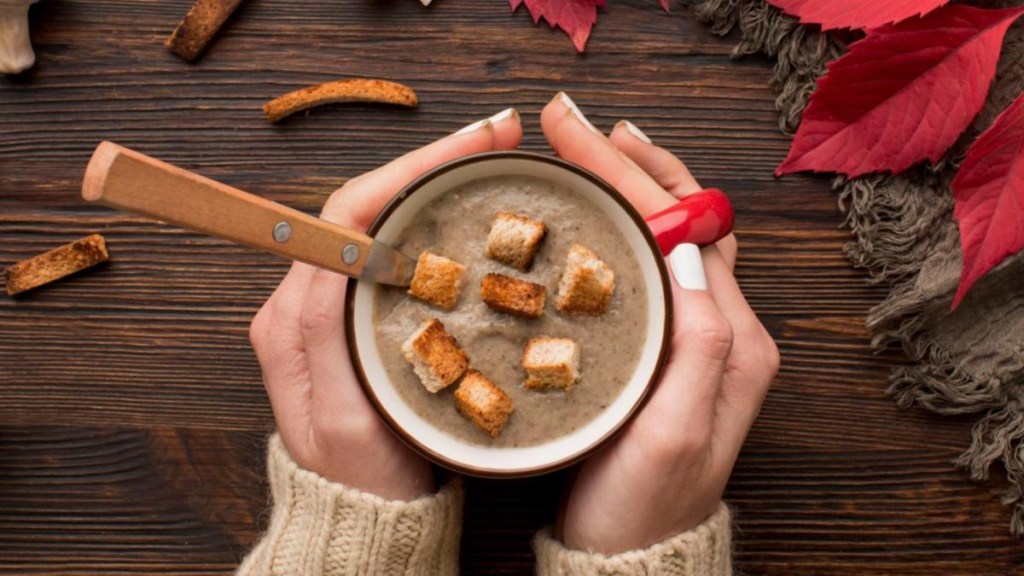The season of sarson ka saag, makke ki roti, gajar halwa, and piping hot soups is finally here. A time when seasonal produce is aplenty, and so are festivals and weddings, offering much scope to indulge. However, winters also bring with it colds, coughs, flu and such ailments. With the cold weather often compromising movement and immunity, food assumes a crucial place. But what to pick when options are galore – from myriad varieties of stuffed parathas to seasonal mithais and healthy millets to that comfortable bowl of warm thukpa, and cups after cups of tea and coffee? “Digestion is more powerful during winters compared to the summer months. Hence, heavier foods like fats, oils and seeds are highly recommended,” says Sreemathy Venkatraman, a wellness nutritionist, clinical dietician and founder of Mitha Ahara: Eat to Live. Also, your immunity needs that much-needed boost. Hence, focus on “fresh and wholesome” foods such as fresh fruits and vegetables, nuts/oilseeds, whole grains/legumes, lean meat and some spices. “These protect against cold and infections,” says Ritika Samaddar, regional head – south zone, dietetics, nutrition and dietetics, Max Super Speciality Hospital, Saket.
Winters also call for warm and comforting foods such as hot soups and beverages, which remain the top favourites. “One can also have foods high in protein such as lean meats (poultry) and eggs along with whole grains such as pulses and millets,” Samaddar adds, sharing some of her winter favourites that include fresh lentil soups, broccoli soup, chicken soup, sheera; Spanish omelette, sarso ka saag with makki ki roti; moong dal halwa; rajma-chawal; bajra ki khichdi; shakarkandi chaat, and gajar ka halwa.
Veggie power
Although leafy greens are recommended for every season, experts say, they assume much significance during winters, both due to the health benefits along with the wide range of options available.
“Winter season blesses us abundantly with a variety of green leafy vegetables such as spinach, mustard leaves, amaranth, radish leaves, fenugreek leaves, bathua, etc. So, it is better to include in your diet whatever is local and seasonal. These are power-packed with various nutrients like iron, calcium, potassium, magnesium, fibre, phytochemicals, etc with fewer calories, and are beneficial for anaemia, diabetes, constipation, vision, heart health, weight loss, etc,” says Ruchika Jain, chief clinical nutritionist, Fortis Hospital, Vasant Kunj. These are versatile and can be eaten in various delicious forms, such as in parathas, theplas, rolls, soups, sauteed, etc.
Along with leafy greens, root vegetables, too, are much in season during winters. Vegetables such as “turnip, sweet potato, arbi, and different varieties of yam are not only delicious but are excellent in winters. These contain a lot of fibre and micro-minerals. Another root – ginger, is good for digestion and can be added to your masala chai, and in different gravies, which is a common practice in India. Also good to use are beetroot, carrot, yams, onion, garlic, radish, and even turmeric roots. These are anti-inflammatory, and have lots of minerals, fibre, starch, and are great for gut health,” says Venkatraman. Again, a versatile lot, these can be added to gravies, kurmas and soups, and can also be a great snack. You can prepare one with that bland arbi (taro), which surprisingly makes for a deliciously healthy snack.
- Take some arbi – either pressure-cooked or boiled well
- Marinate it with some salt, pepper, chilli powder and a dash of lime
- Instead of deep-frying, pan fry it on a tawa with some good oil, and enjoy it with your evening tea
Root vegetables also go well in soups. “They offer better thickening and are also very filling compared to adding just plain vegetables. Also, add some fresh turmeric in your soups and infusions,” recommends Venkatraman.
Fruity fare
During this season, one is more prone to colds and respiratory infections. “Here, a diet rich in vitamin C and anti-inflammatory foods can help. Nature has provided us with such fruits in winters that are high in vitamin C, such as citrus fruits and berries along with plums, etc, which are high in anti-inflammatory factors,” says Samaddar. Such fruits include orange, guava, pineapple, strawberry, sweet lime and figs, among others.
Cereal numbers
From Punjab’s makke ki roti to Rajasthan’s bajre ki khichdi; the cereal heterogeneity deliciously comes to the forefront during these months. Not only are these tasty, but are fully packed with essential nutrients.
According to Samaddar, one should have whole grains such as millets, whole wheat flour, dalia, oats, etc, which are extremely healthy. At the same time, “avoid the intake of refined flour and processed grains like maida, bread, buns, pasta, etc, as they are inflammatory in nature”.
Spicing it up
As the mercury drops, our national beverage – masala chai (of course) – rises on the popularity chart. Not only in the usual chai, spices, in general, are beneficial during winters. “Spices are loaded with antioxidants, antibacterial and anti-inflammatory properties that help to build the immunity and also help maintain the body temperature besides providing the health benefits,” explains Samaddar. Some of the spices she recommends include ginger, clove, cinnamon, and turmeric, all of which have anti-inflammatory properties and also help with digestion. However, a word of caution. “Do not overload yourself with excess intake of spices, that can cause toxicity and affect the liver,” she adds.
Seasonal superfoods
Like in every season, dry fruits are beneficial during winters as these are “superfoods” and are “loaded with proteins in addition to being high on fibre and healthy fats. Also, nuts are high in micronutrients, such as iron, magnesium, calcium, zinc, etc, which help in building immunity. So one can have a handful of almonds, a couple of walnuts daily, and replace the unhealthy snacks with nuts,” says Samaddar.
Beyond tea & coffee
Yes, those incessant rounds of tea and coffee can be comforting during winter. But one must look at other ways to hydrate. Apart from the usual fluids, one can try warm infusions. For example, in tulsi water, add some cinnamon sticks, two or three cloves, cardamom, a piece of jaggery or honey, and diced dates. “Boil these in a litre of water, and keep them steeped for a while. You can have this decoction throughout the day. You can carry it with you to work. It hydrates and also improves immunity. As people love to drink hot beverages during this season, this is the best way for hydration, and not just caffeine as that dehydrates you,” says Venkatraman.
Ghee, oils: Good or bad?
During winter, digestion is better than in other seasons. Hence, eating good amounts of ghee and oil is generally recommended. However, a dense number of calories remains a concern. “Ghee and oils generate heat for the body, which is beneficial against the dipping temperature. So, you do burn a lot of calories to keep yourself warm,” says Venkatraman. Here, oils and ghee serve as dense sources of calories. However, she is critical of the Western fad of having two tablespoons of ghee first thing in the morning. “For us, the best ways are the traditional ones of adding some on a good plate of dal and chawal, or in the form of tadka, or to kurmas and gravies. Ghee is also used extensively in sweets,” she says.
For the sweet tooth
Those decadent sweets and the idea of good health are often at odds with one another. However, with several festivals lined up along with the zillions of weddings that take place during winter, it is hardly possible to steer clear of mithais. Also, many of these are seasonal – from gajar ka halwa to gond and til laddoo; further making a case for a little bit of indulgence. According to Jain, one can satiate that sugar craving with dishes like halwa, peanut chikki, dates barfi, gajar paak, anjeer nuts barfi, gajar ki kheer, gond ke laddoo, til laddoo, walnut barfi, coconut barfi, etc, by “keeping portion control and ingredients in mind”.
Street food basics
When speaking of India’s food scene, it is impossible to not talk about street foods. “During winters, one prefers warm foods. Talking of street foods, one should eat whatever is freshly made and is heated well like moong dal halwa, dal vada, tikkis, etc,” says Samaddar. Venkatraman recommends street foods that are hygienic and are cooked well. “I wouldn’t recommend anything that is completely raw,” she says. As one’s dietary requirements change during winter, so are the foods that are seasonal. What is required are energy-dense foods such as oil and ghee, along with root and green leafy vegetables, fruits rich in vitamins C and D, along with warm infusions to remain hydrated. There are foods to be avoided, such as “stale, refrigerated and cold foods,” says Venkatraman.
Snacking for good health
For mid-morning or evening slump, munch on…
- Roasted foxnuts
- Roasted peanuts
- Groundnut chikki
- Til patti made with sesame seeds, jaggery
- Some egg preparations
- Seasonal vegetables such as carrots, radish, and beetroot
- Fruits such as oranges, apples, and guavas
Curd, buttermilk: Yay or nay?
Curd and its preparations are healthy but some people say they are not to be consumed in winters…
- Curd is gut-friendly and helps to boost immunity
- It’s a source of probiotics, protein, calcium, magnesium
- There is no contraindication clinically to include curd in winter
- If it doesn’t suit someone, they can take freshly made curd at room temperature during daytime
Soups for winters
- Homemade soups without adding thickeners or sauces are healthier
- Use ingredients like ginger, garlic, basil, coriander, spring onion, black pepper
- Carrot beetroot tomato soup, spinach soup, veg shorba, broccoli soup, chicken or sweet corn are good examples








